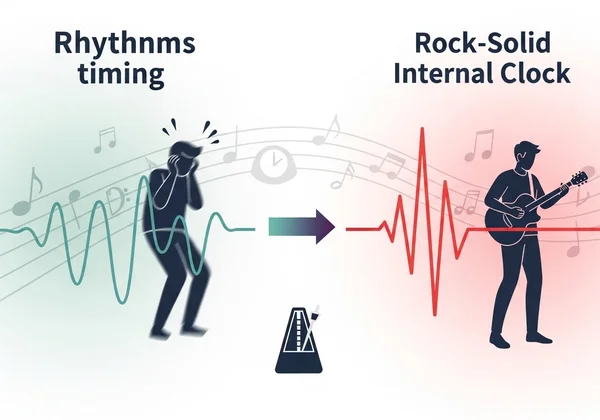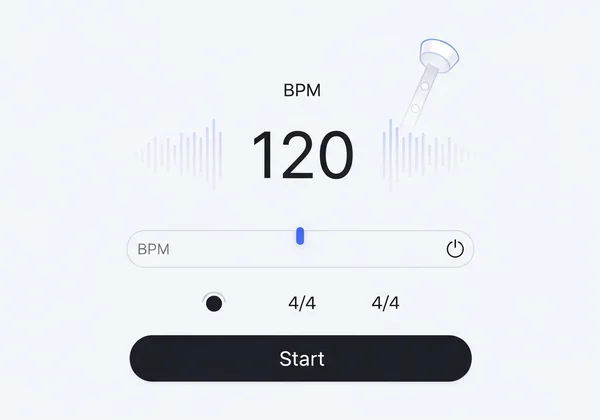30-Day Rhythm Challenge: Master Your Musical Timing Online
Feeling stuck with inconsistent timing or a shaky groove? Imagine transforming your rhythm from hesitant to rock-solid in just one month. Many musicians struggle with this, but the solution is simpler and more accessible than you think. This guide introduces the ultimate 30-day rhythm challenge, a systematic plan designed to build a powerful internal clock and elevate your musicality. So, how can a metronome improve my playing? By providing a steady, reliable pulse, it becomes your most honest practice partner, and with the powerful, free tool at Metronome Online, you have everything you need to begin. Get ready to unlock your full rhythmic potential and start your journey today!

Why a 30-Day Rhythm Challenge Matters for Musicians
Embarking on a structured challenge is more than just practice; it's a commitment to foundational improvement. Rhythm is the backbone of music, and strengthening it has a profound impact on every note you play. This challenge provides the framework to turn a common weakness into your greatest strength, using a dedicated rhythm practice tool.
Overcoming Common Timing & Groove Challenges
Every musician, from beginner to advanced, has faced rhythmic hurdles. You might rush through fast passages, drag during slow sections, or find your playing feels stiff and mechanical. This uneven playing can undermine an otherwise great performance. The root of these issues is often a less-developed internal metronome. A structured challenge forces you to confront these tendencies head-on, creating the muscle memory and mental awareness needed to achieve a deep, consistent groove.
The Core Benefits of Structured Daily Rhythm Practice
Sporadic practice yields sporadic results. A daily commitment, even for just 15 minutes, creates compounding returns. The primary benefit is internal clock development; your brain learns to anticipate the beat, making your timing intuitive and natural. This leads to rapid growth across all areas of your playing, from scale runs to complex solos. Structured practice builds confidence, allowing you to play with more authority and collaborate more effectively with other musicians. For deeper dives into music theory and the science behind rhythm, you can consult resources from Berklee Online.
Your Metronome Practice Plan: The 30-Day Journey Explained
This is your roadmap to rhythmic precision. The plan is broken into four progressive weeks, each building on the last. The goal isn't just to play with a metronome, but to internalize the beat so deeply that it becomes a part of you. All you need is your instrument and our free metronome.
Getting Started with Your Online Metronome
Before we begin, let's get you set up. Navigate to our free metronome. You'll see the interface is clean and ready to go—no downloads or sign-ups required. For beginners, the process is simple: use the slider or type in a number for setting your BPM (Beats Per Minute), choose a time signature (start with 4/4), and press "Start." You now have a steady click to guide your practice. It's the perfect entry point for anyone wondering how to use a metronome for beginners.

Weekly Focus: Progressive Rhythm Exercises (Weeks 1-4)
Consistency is key. Dedicate 15-20 minutes each day to these exercises.
Week 1: Building a Solid Foundation (Steady Tempo & Basic Subdivisions)
The first week is all about stability. Set your online metronome to a slow tempo, like 60 BPM. Your goal is to play a single note perfectly on each click (quarter notes). Focus on the space between the notes, ensuring it's perfectly even. As you get comfortable, play two notes per click (eighth notes). Gradually increase the tempo throughout the week to 70, 80, and 90 BPM, but only when you feel completely locked in with the click.
Week 2: Expanding Your Rhythmic Vocabulary (Eighths, Sixteenths, Triplets)
Now, we introduce complexity. Using the subdivision feature on our metronome online, you can add more intricate rhythms. Start by switching between eighth notes (two notes per click) and sixteenth notes (four notes per click) without losing the beat. Then, explore triplets—three evenly spaced notes per click. This week challenges your brain to think in different rhythmic layers while maintaining a solid pulse.
Week 3: Developing Internal Clock & Groove (Silent Bars & Dynamic Practice)
This week is where the magic happens. We'll train your internal clock. Set the metronome to play for one measure and then be silent for the next. During the silent measure, keep playing and try to land perfectly on the "one" when the click returns. This exercise, a form of dynamic practice, forces you to generate the time yourself. It’s challenging but incredibly effective for building true rhythmic independence.
Week 4: Applying Rhythm to Music (Phrasing, Legato, Staccato)
In the final week, we apply your newfound skills to real music. Take a simple scale or a short musical phrase you know well. Practice playing it with different articulations—smooth and connected (legato) versus short and detached (staccato)—all while staying perfectly in time. Focus on how rhythm shapes the musicality of the phrase. This bridges the gap between mechanical practice and expressive performance.
Recommended Daily Practice Routine & Duration
For this challenge to work, consistency trumps duration. Aim for a focused 15-20 minute session every day. Start each session with a 5-minute warm-up of simple quarter notes to lock into the beat. Then, spend 10-15 minutes on the specific exercise for that week. This consistent practice approach prevents burnout and makes the habit of metronome use stick.
Maximizing Your Rhythm Bootcamp Experience with MetronomeOnline.org
Our tool is more than just a click track; it's a full-featured rhythm bootcamp designed to enhance your practice. By using its features, you can take this challenge to the next level. Ready to see what it can do? Explore these features on our homepage.
Leveraging Advanced Metronome Features for Deeper Practice
Don't just stick to the basics. Want to figure out the tempo of your favorite song? Use the tap tempo feature by clicking a button in time with the music. The BPM will be calculated for you. Experiment with different beat subdivisions to practice complex genres like swing or funk. Change the sound of the click to one you find pleasing. The time signature metronome allows you to practice in unconventional meters, expanding your musical horizons.
Tips for Staying Motivated and Tracking Progress
A 30-day challenge requires motivation. Use the built-in practice timer on our platform to log your daily sessions. Keep a simple practice journal: note the date, BPM, and the exercises you worked on. Write down one small victory from each session, whether it was nailing a tricky passage or just feeling more "in the pocket." Seeing this progress on paper fuels your drive to keep going.
![]()
Your Path to Rhythmic Mastery Starts Today!
You've read the plan, and you understand the benefits. The only thing left is to begin. In 30 days, you can fundamentally transform your sense of time and groove, building a foundation that will serve you for your entire musical life. Every great musician has a powerful connection to rhythm, and that journey starts with a single, steady click.
Our online metronome is here to be your free, reliable, and powerful partner on this journey. So, head over to the homepage, set your first tempo, and take the first step.
Ready to accept the challenge? Start the challenge now!
Frequently Asked Questions About Rhythm & Metronomes
What is a good tempo for practice?
There's no single "best" tempo. The golden rule is to start at a speed where you can play a passage perfectly and cleanly. For many, this is a slow tempo like 60-80 BPM. The goal is to build accuracy first, then gradually increase the speed using your online metronome by 4-5 BPM at a time only after you've achieved mastery at the current speed.
How can a metronome improve my playing?
A metronome acts as an objective judge of your timing. It helps you identify and correct tendencies to speed up or slow down, builds a rock-solid internal clock, improves your accuracy and clarity, and allows you to measure your progress objectively. Ultimately, it makes your playing more professional, confident, and groovy.
How do I find the BPM of a song using a metronome?
The easiest way is with the "Tap Tempo" feature. While listening to the song, simply tap a key or click the "Tap BPM" button on our site in time with the beat. The tool will automatically calculate the song's BPM. This is perfect for learning new songs or setting your practice speed to match a recording. You can try the tap tempo feature right now.
How to use a metronome for beginners?
Start simple. Go to a free metronome like ours. Set the time signature to 4/4 and the tempo to a comfortable, slow speed like 70 BPM. Press start and listen to the click. First, just clap along. Then, try playing a single note on your instrument for each click. The goal is to perfectly align your note with the sound of the metronome.